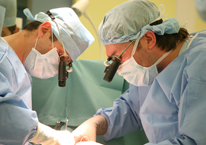
Angioplasty is a procedure of opening the damaged artery using a thin catheter that has an expandable balloon on its tip. A stent is a mesh-like device implanted into the artery that keeps it open, ensuring the sufficient blood flow.
Arteries may be affected in any body part. In case the vessels supplying blood to the heart are blocked, the procedure is called percutaneous coronary intervention (PCI). It can be also called coronary angioplasty or percutaneous transluminal coronary angioplasty (PTCA).
When is angioplasty performed?
The arteries may be closed (occluded) or narrowed (stenotic) with atheromatous plaques. An atheromatous plaque is caused by deposition of fats, cholesterol and other substances on inner walls of artery.
Angioplasty is used for the treatment of symptoms caused by:
- Ischemic heart disease (stenosis or occlusion of the arteries supplying blood to the heart);
- Diseases of peripheral vessels (stenosis or occlusion of the arteries supplying blood to limbs, especially legs);
- Damage of the carotid artery (stenosis of the internal carotid artery);
- Renovascular disease (stenosis of the renal artery).
How to prepare yourself for angioplasty?
- Ask your doctor if you are supposed to take any medicines before the procedure. Your doctor may prescribe medication to prevent clottage during the procedure.
- Ask anyone to take you home after the treatment beforehand.
- Tell your doctor if you have any renal problems or are allergic to iodine-containing products or chemical substances such as shellfish or radiographic contrast medium.
- Before the procedure you will have to sign your consent to angioplasty and angiography (angiography is the X-ray study of the blood vessels using the radiographic contrast medium).
- It is not allowed to eat or drink for the period of at least 4 hours before the procedure.
- Before the procedure you will undergo examination including blood tests, electrocardiogram (ECG) and any other tests as required.
What happens during the procedure?
You will be given medication that will help you relax and reduce emotional tension. Then the area of catheter introduction will be anesthetized locally. You may be sleeping during the procedure.
The day before the surgery, you should shave and clean the area of possible puncture (wrist, elbow and groin area) to prevent infection.
Your doctor will insert a catheter into the blood vessel, either in your arm or in your groin. The catheter is a very thin and flexible tube. The X-rays are used to observe the catheter movement along the vessels and its location. The guidewire is passed through the narrowed vessel. Next a mini-catheter with an expandable micro-balloon on its tip (balloon catheter) is fed through the guidewire. When the balloon catheter reaches the narrowed part of the artery, the balloon is inflated thus widening the affected area of the artery. Then a stent is placed into this area to create an adequate frame inside the artery. Thus, the lumen of the artery becomes sufficient for improving blood flow. The stent may be drug-eluting or bare. After the stent is implanted, all the instruments are removed.
What happens after the procedure?
After the procedure a compressive bandage will be applied on the puncture area to prevent bleeding. Then you will be taken to the ward to have a rest.Duration of hospital stay depends on the peculiarities of the surgery performed and the postoperative period, and usually takes from 1 to 3 days after the procedure.
Angioplasty has good long-term outcomes. Angioplasty success reaches 100%. However, sometimes in more complicated cases of coronary artery damage angioplasty is difficult to be performed. Sometime, there is in-stent narrowing (restenosis), which usually occurs within 6 months after the procedure.
What are the advantages of angioplasty?
- Angioplasty is the minimally invasive procedure performed through a small puncture in the skin, in contrast to the сoronary artery bypass surgery in which the chest is cut open.
- The procedure is performed without general anesthesia.
What are the risks of angioplasty?
- Very rarely, there may be an allergic reaction to local anesthetic or radiographic contrast medium.
- The artery injury by the guidewire is possible, which sometimes requires urgent open surgery.
- There is a risk of hematoma development in the puncture area.
- Stroke is possible.
How can I take care of myself?
- Don’t smoke.
- Eat healthy low-fat and low-cholesterol food.
- Exercise according to your doctor’s recommendations.
- Regularly visit your doctor and follow his/her advices.
When shall I call the ambulance?
Call 03 if:
- You feel chest compression, pressure or pain, which lasts for more than 5 minutes, or if these symptoms disappear and then return.
- You feel pain or discomfort in one or both arms, neck, jaw or back which last for more than 5 minutes, or if these symptoms disappear and then return. Also if you experience dizziness, laborious breathing, nausea or perceptible precipitation.
- You experience shortness of breath.
- Your arm or leg becomes blue and cold.
Call your doctor if:
- You experience persistent or growing pain or numbness in your arm or leg.
- You have a fever.
- There is bleeding, hematoma or swelling in the puncture area.
- You have questions on the procedure performed or its result.
- You have questions on any test or intervention.
